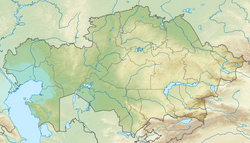| Neocomian Sands | |
|---|---|
| Stratigraphic range: Berriasian-Hauterivian ~ | |
| Type | Geological formation |
| Lithology | |
| Primary | Sandstone |
| Location | |
| Coordinates | 47°06′N51°54′E / 47.1°N 51.9°E |
| Approximate paleocoordinates | 41°48′N55°06′E / 41.8°N 55.1°E |
| Region | Atyrau |
| Country | Kazakhstan |
| Type section | |
| Named for | Neocomian (Early Cretaceous) |
The Neocomian Sands is an Early Cretaceous geologic formation in Atyrau, Kazakhstan. [1] Dinosaur remains have been recovered from the formation. [2]
